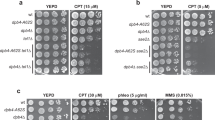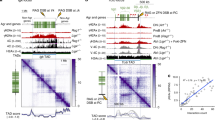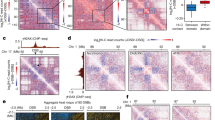Abstract
The cellular DNA-damage response is a signaling network that is vigorously activated by cytotoxic DNA lesions, such as double-strand breaks (DSBs)1. The DSB response is mobilized by the nuclear protein kinase ATM, which modulates this process by phosphorylating key players in these pathways2. A long-standing question in this field is whether DSB formation affects chromatin condensation. Here, we show that DSB formation is followed by ATM-dependent chromatin relaxation. ATM's effector in this pathway is the protein KRAB-associated protein (KAP-1, also known as TIF1β, KRIP-1 or TRIM28), previously known as a corepressor of gene transcription3,4. In response to DSB induction, KAP-1 is phosphorylated in an ATM-dependent manner on Ser 824. KAP-1 is phosphorylated exclusively at the damage sites, from which phosphorylated KAP-1 spreads rapidly throughout the chromatin. Ablation of the phosphorylation site of KAP-1 leads to loss of DSB-induced chromatin decondensation and renders the cells hypersensitive to DSB-inducing agents. Knocking down KAP-1, or mimicking a constitutive phosphorylation of this protein, leads to constitutive chromatin relaxation. These results suggest that chromatin relaxation is a fundamental pathway in the DNA-damage response and identify its primary mediators.
This is a preview of subscription content, access via your institution
Access options
Subscribe to this journal
Receive 12 print issues and online access
$209.00 per year
only $17.42 per issue
Buy this article
- Purchase on SpringerLink
- Instant access to full article PDF
Prices may be subject to local taxes which are calculated during checkout




Similar content being viewed by others
References
Bassing, C. H. & Alt, F. W. The cellular response to general and programmed DNA double strand breaks. DNA Repair 3, 781–796 (2004).
Shiloh, Y. The ATM-mediated DNA-damage response: taking shape. Trends Biochem. Sci. doi:10.1016/j.tibs.2006.05.004 (2006).
Friedman, J. R. et al. KAP-1, a novel corepressor for the highly conserved KRAB repression domain. Genes Dev. 10, 2067–2078 (1996).
Le Douarin, B. et al. A possible involvement of TIF1α and TIF1β in the epigenetic control of transcription by nuclear receptors . EMBO J 15, 6701–6715 (1996).
Shiloh, Y. ATM and related protein kinases: safeguarding genome integrity. Nature Rev. Cancer 3, 155–168 (2003).
Bakkenist, C. J. & Kastan, M. B. Initiating cellular stress responses. Cell 118, 9–17 (2004).
Shechter, D., Costanzo, V. & Gautier, J. Regulation of DNA replication by ATR: signaling in response to DNA intermediates. DNA Repair 3, 901–908 (2004).
Shinozaki, T., Nota, A., Taya, Y. & Okamoto, K. Functional role of Mdm2 phosphorylation by ATR in attenuation of p53 nuclear export. Oncogene 22, 8870–8880 (2003).
Moosmann, P., Georgiev, O., Le Douarin, B., Bourquin, J. P. & Schaffner, W. Transcriptional repression by RING finger protein TIF1β that interacts with the KRAB repressor domain of KOX1. Nucleic Acids Res. 24, 4859–4867 (1996).
Kim, S. S. et al. A novel member of the RING finger family, KRIP-1, associates with the KRAB-A transcriptional repressor domain of zinc finger proteins. Proc. Natl Acad. Sci. USA 93, 15299–15304 (1996).
Reymond, A. et al. The tripartite motif family identifies cell compartments. EMBO J. 20, 2140–2151 (2001).
Schultz, D. C., Ayyanathan, K., Negorev, D., Maul, G. G. & Rauscher, F. J., 3rd. SETDB1: a novel KAP-1-associated histone H3, lysine 9-specific methyltransferase that contributes to HP1-mediated silencing of euchromatic genes by KRAB zinc-finger proteins. Genes Dev. 16, 919–932 (2002).
Ayyanathan, K. et al. Regulated recruitment of HP1 to a euchromatic gene induces mitotically heritable, epigenetic gene silencing: a mammalian cell culture model of gene variegation. Genes Dev. 17, 1855–1869 (2003).
Cammas, F., Mark, M., Dolle, P., Chambon, P., Losson, R. Mice lacking the transcriptional corepressor TIF1β are defective in early post implantation development. Development 127, 2955–2963 (2000).
Lukas, C., Falck, J., Bartkova, J., Bartek, J. & Lukas, J. Distinct spatiotemporal dynamics of mammalian checkpoint regulators induced by DNA damage. Nature Cell Biol. 5, 255–260 (2003).
Telford, D. J. & Stewart, B. W. Micrococcal nuclease: its specificity and use for chromatin analysis. Int. J. Biochem. 21, 127–137 (1989).
Biton, S. et al. Nuclear ATM mediates the cellular response to DNA double-strand breaks in human neuron-like cells. J. Biol. Chem. 281, 17482–17491 (2006).
Lu, Q. & Richardson, B. DNaseI hypersensitivity analysis of chromatin structure. Methods Mol. Biol. 287, 77–86 (2004).
Gontijo, A. M., Green, C. M. & Almouzni, G. Repairing DNA damage in chromatin. Biochimie 85, 1133–1147 (2003).
Verger, A. & Crossley, M. Chromatin modifiers in transcription and DNA repair. Cell Mol. Life Sci. 61, 2154–2162 (2004).
Muller, W. G., Walker, D., Hager, G. L. & McNally, J. G. Large-scale chromatin decondensation and recondensation regulated by transcription from a natural promoter. J. Cell Biol. 154, 33–48 (2001).
Ye, Q. et al. BRCA1-induced large-scale chromatin unfolding and allele-specific effects of cancer-predisposing mutations. J. Cell Biol. 155, 911–921 (2001).
Nye, A. C. et al. Alteration of large-scale chromatin structure by estrogen receptor. Mol. Cell Biol. 22, 3437–3449 (2002).
Carpenter, A. E., Memedula, S., Plutz, M. J. & Belmont, A. S. Common effects of acidic activators on large-scale chromatin structure and transcription. Mol. Cell Biol. 25, 958–968 (2005).
Carrier, F. et al. Gadd45, a p53-responsive stress protein, modifies DNA accessibility on damaged chromatin. Mol. Cell Biol. 19, 1673–1685 (1999).
Rubbi, C. P. & Milner, J. p53 is a chromatin accessibility factor for nucleotide excision repair of DNA damage. EMBO J. 22, 975–986 (2003).
Takahashi, K. & Kaneko, I. Changes in nuclease sensitivity of mammalian cells after irradiation with 60Co γ-rays. Int. J. Radiat. Biol. Relat. Stud. Phys. Chem. Med. 48, 389–395 (1985).
Jaberaboansari, A., Landis, M. R., Wallen, C. A. & Wheeler, K. T. Alterations of neuronal nuclear matrix and chromatin structure after irradiation under aerobic and anoxic conditions. Radiat. Res. 119, 57–72 (1989).
Tsukuda, T., Fleming, A. B., Nickoloff, J. A. & Osley, M. A. Chromatin remodelling at a DNA double-strand break site in Saccharomyces cerevisiae. Nature 438, 379–383 (2005).
Kruhlak, M. J. et al. Changes in chromatin structure and mobility in living cells at sites of DNA double-strand breaks. J. Cell Biol. 172, 823–834 (2006).
Riballo, E. et al. A pathway of double-strand break rejoining dependent upon ATM, Artemis, and proteins locating to γ-H2AX foci. Mol. Cell 16, 715–724 (2004).
Wang, C. et al. MDM2 interaction with nuclear corepressor KAP1 contributes to p53 inactivation. EMBO J. 24, 3279–3290 (2005).
Bhoumik, A. et al. ATM-dependent phosphorylation of ATF2 is required for the DNA damage response. Mol. Cell 18, 577–587 (2005).
Ljungman, M. & Lane, D. P. Transcription — guarding the genome by sensing DNA damage. Nature Rev. Cancer 4, 727–737 (2004).
Birger, Y. et al. Chromosomal protein HMGN1 enhances the rate of DNA repair in chromatin. EMBO J. 22, 1665–1675 (2003).
Ziv, Y. et al. Recombinant ATM protein complements the cellular A–T phenotype. Oncogene 15, 159–167 (1997).
Acknowledgements
We thank M. Oren for alerting us to the DSB response detected by the anti-pS407–Mdm2 antibody, R. Agami for the pRETRO-SUPER vector and one of the sequences used to knock down ATM, Y. Lerenthal for establishing the ATM knockdown HEK293, S. Biton for establishing the ATM knockdown LA-N-5 cells, T. Halazonetis for a gift of anti-53BP1 antibodies and L. Mittelman for expert assistance with confocal microscopy. This work was supported by research grants from the A-T Children's Project, The A-T Medical Research Foundation, The National Institutes of Health (NS31763), the A-T Medical Research Trust, The A-T Ease Foundation, The European Union, the Danish National Research Foundation, and the John and Birthe Meyer Foundation. This work was carried out in partial fulfillment of the requirements for the Ph.D. degree of D.B.
Author information
Authors and Affiliations
Corresponding authors
Ethics declarations
Competing interests
The authors declare no competing financial interests.
Supplementary information
Supplementary Information
Supplementary Figures S1, S2, S3, S4, S5, S6, S7 and S8 (PDF 3288 kb)
Rights and permissions
About this article
Cite this article
Ziv, Y., Bielopolski, D., Galanty, Y. et al. Chromatin relaxation in response to DNA double-strand breaks is modulated by a novel ATM- and KAP-1 dependent pathway. Nat Cell Biol 8, 870–876 (2006). https://doi.org/10.1038/ncb1446
Received:
Accepted:
Published:
Issue Date:
DOI: https://doi.org/10.1038/ncb1446



